Accounting Concepts and Practices: Comparing Financial Statements
VerifiedAdded on 2019/11/08
|11
|1895
|56
Homework Assignment
AI Summary
This assignment examines accounting concepts and practices, focusing on the generally accepted accounting principles (GAAP) and their application in financial statements. The discussion includes the implications of accounting conventions, standards, consolidation, and foreign currencies, particularly when comparing companies like Nestle (USA) and Patties Food Limited (Australia), which follow different GAAP frameworks (IASB and AASB, respectively). The assignment highlights similarities and differences between IASB and AASB, especially regarding consolidation and foreign currency transactions. It also analyzes the impact of changes in IFRS on companies like Nestle and discusses Nestle's business strategy and corporate governance. Furthermore, the assignment provides adjusting journal entries, an adjusted trial balance, an income statement, a statement of changes in equity, and a statement of financial position for a specific period, demonstrating practical application of accounting principles. The assignment covers the basic accounting principles and concepts, historical cost, monetary unit assumption, and economic entity assumption.
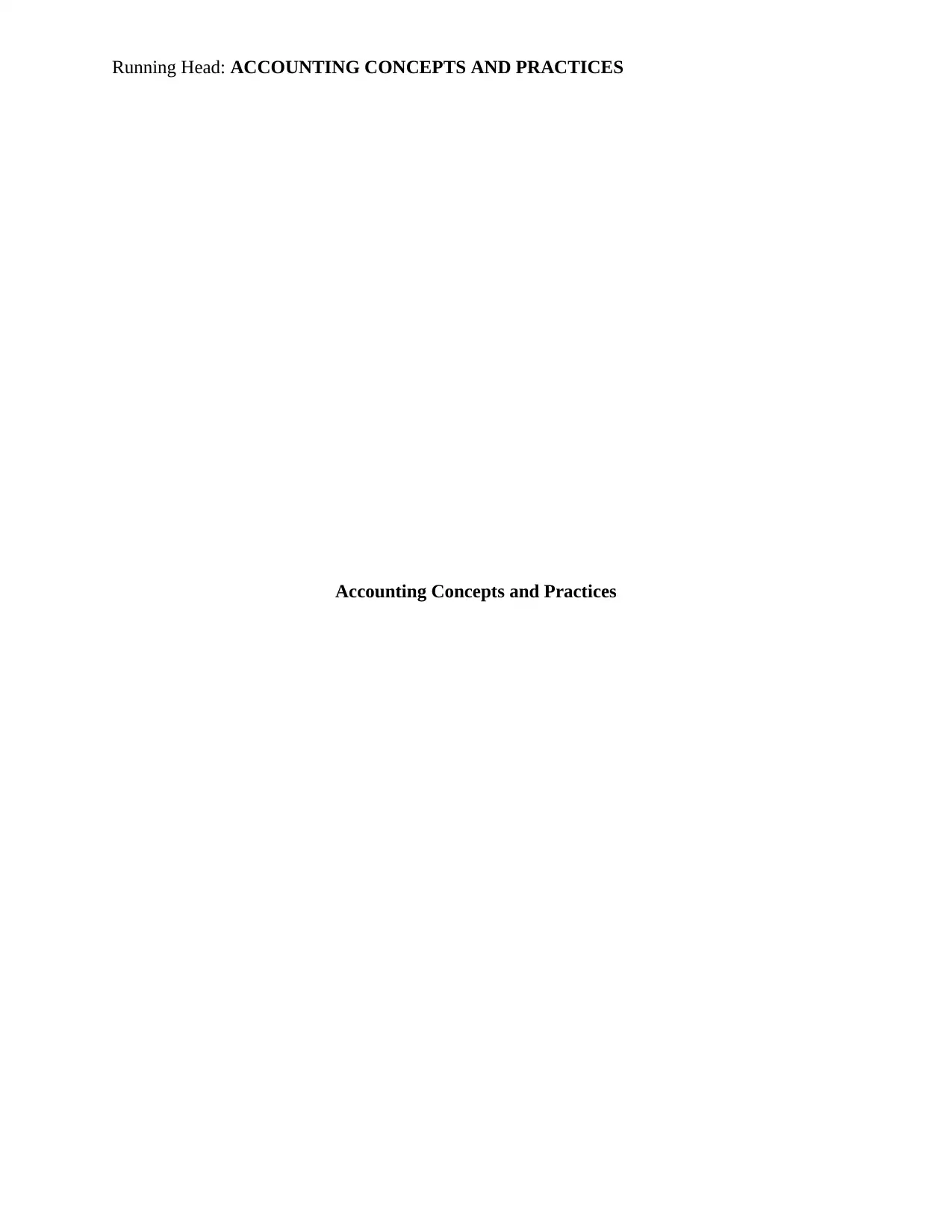
Running Head: ACCOUNTING CONCEPTS AND PRACTICES
Accounting Concepts and Practices
Accounting Concepts and Practices
Paraphrase This Document
Need a fresh take? Get an instant paraphrase of this document with our AI Paraphraser
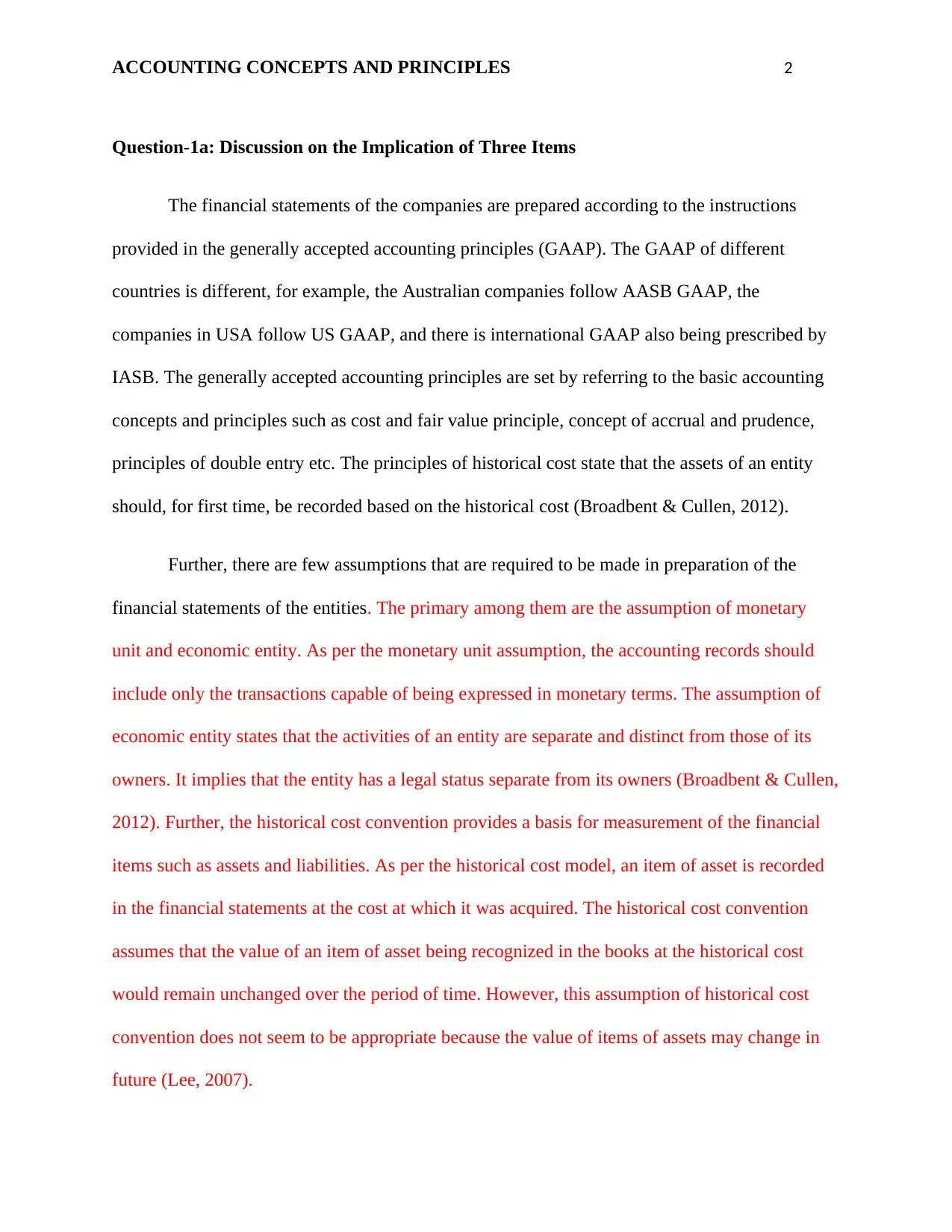
ACCOUNTING CONCEPTS AND PRINCIPLES 2
Question-1a: Discussion on the Implication of Three Items
The financial statements of the companies are prepared according to the instructions
provided in the generally accepted accounting principles (GAAP). The GAAP of different
countries is different, for example, the Australian companies follow AASB GAAP, the
companies in USA follow US GAAP, and there is international GAAP also being prescribed by
IASB. The generally accepted accounting principles are set by referring to the basic accounting
concepts and principles such as cost and fair value principle, concept of accrual and prudence,
principles of double entry etc. The principles of historical cost state that the assets of an entity
should, for first time, be recorded based on the historical cost (Broadbent & Cullen, 2012).
Further, there are few assumptions that are required to be made in preparation of the
financial statements of the entities. The primary among them are the assumption of monetary
unit and economic entity. As per the monetary unit assumption, the accounting records should
include only the transactions capable of being expressed in monetary terms. The assumption of
economic entity states that the activities of an entity are separate and distinct from those of its
owners. It implies that the entity has a legal status separate from its owners (Broadbent & Cullen,
2012). Further, the historical cost convention provides a basis for measurement of the financial
items such as assets and liabilities. As per the historical cost model, an item of asset is recorded
in the financial statements at the cost at which it was acquired. The historical cost convention
assumes that the value of an item of asset being recognized in the books at the historical cost
would remain unchanged over the period of time. However, this assumption of historical cost
convention does not seem to be appropriate because the value of items of assets may change in
future (Lee, 2007).
Question-1a: Discussion on the Implication of Three Items
The financial statements of the companies are prepared according to the instructions
provided in the generally accepted accounting principles (GAAP). The GAAP of different
countries is different, for example, the Australian companies follow AASB GAAP, the
companies in USA follow US GAAP, and there is international GAAP also being prescribed by
IASB. The generally accepted accounting principles are set by referring to the basic accounting
concepts and principles such as cost and fair value principle, concept of accrual and prudence,
principles of double entry etc. The principles of historical cost state that the assets of an entity
should, for first time, be recorded based on the historical cost (Broadbent & Cullen, 2012).
Further, there are few assumptions that are required to be made in preparation of the
financial statements of the entities. The primary among them are the assumption of monetary
unit and economic entity. As per the monetary unit assumption, the accounting records should
include only the transactions capable of being expressed in monetary terms. The assumption of
economic entity states that the activities of an entity are separate and distinct from those of its
owners. It implies that the entity has a legal status separate from its owners (Broadbent & Cullen,
2012). Further, the historical cost convention provides a basis for measurement of the financial
items such as assets and liabilities. As per the historical cost model, an item of asset is recorded
in the financial statements at the cost at which it was acquired. The historical cost convention
assumes that the value of an item of asset being recognized in the books at the historical cost
would remain unchanged over the period of time. However, this assumption of historical cost
convention does not seem to be appropriate because the value of items of assets may change in
future (Lee, 2007).
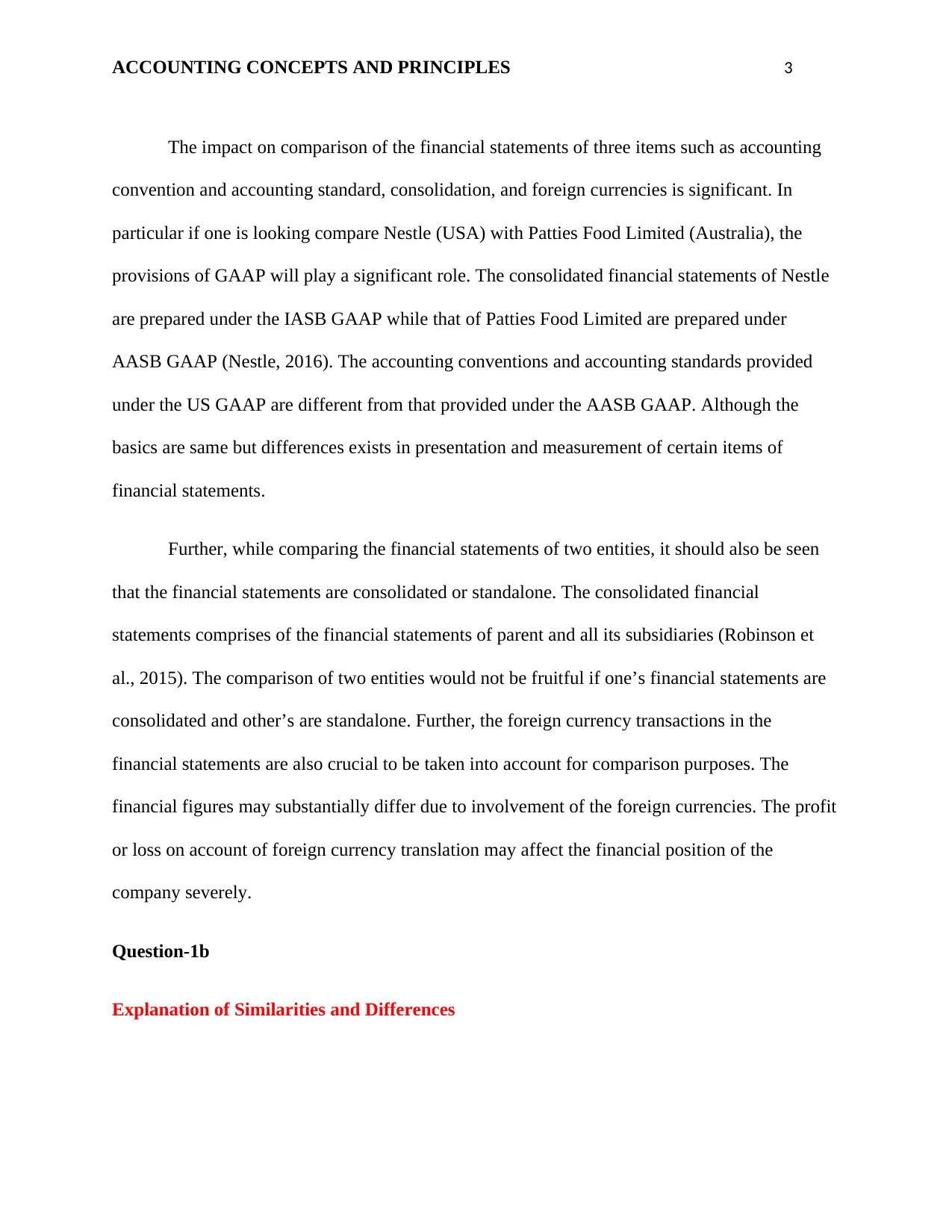
ACCOUNTING CONCEPTS AND PRINCIPLES 3
The impact on comparison of the financial statements of three items such as accounting
convention and accounting standard, consolidation, and foreign currencies is significant. In
particular if one is looking compare Nestle (USA) with Patties Food Limited (Australia), the
provisions of GAAP will play a significant role. The consolidated financial statements of Nestle
are prepared under the IASB GAAP while that of Patties Food Limited are prepared under
AASB GAAP (Nestle, 2016). The accounting conventions and accounting standards provided
under the US GAAP are different from that provided under the AASB GAAP. Although the
basics are same but differences exists in presentation and measurement of certain items of
financial statements.
Further, while comparing the financial statements of two entities, it should also be seen
that the financial statements are consolidated or standalone. The consolidated financial
statements comprises of the financial statements of parent and all its subsidiaries (Robinson et
al., 2015). The comparison of two entities would not be fruitful if one’s financial statements are
consolidated and other’s are standalone. Further, the foreign currency transactions in the
financial statements are also crucial to be taken into account for comparison purposes. The
financial figures may substantially differ due to involvement of the foreign currencies. The profit
or loss on account of foreign currency translation may affect the financial position of the
company severely.
Question-1b
Explanation of Similarities and Differences
The impact on comparison of the financial statements of three items such as accounting
convention and accounting standard, consolidation, and foreign currencies is significant. In
particular if one is looking compare Nestle (USA) with Patties Food Limited (Australia), the
provisions of GAAP will play a significant role. The consolidated financial statements of Nestle
are prepared under the IASB GAAP while that of Patties Food Limited are prepared under
AASB GAAP (Nestle, 2016). The accounting conventions and accounting standards provided
under the US GAAP are different from that provided under the AASB GAAP. Although the
basics are same but differences exists in presentation and measurement of certain items of
financial statements.
Further, while comparing the financial statements of two entities, it should also be seen
that the financial statements are consolidated or standalone. The consolidated financial
statements comprises of the financial statements of parent and all its subsidiaries (Robinson et
al., 2015). The comparison of two entities would not be fruitful if one’s financial statements are
consolidated and other’s are standalone. Further, the foreign currency transactions in the
financial statements are also crucial to be taken into account for comparison purposes. The
financial figures may substantially differ due to involvement of the foreign currencies. The profit
or loss on account of foreign currency translation may affect the financial position of the
company severely.
Question-1b
Explanation of Similarities and Differences
⊘ This is a preview!⊘
Do you want full access?
Subscribe today to unlock all pages.

Trusted by 1+ million students worldwide
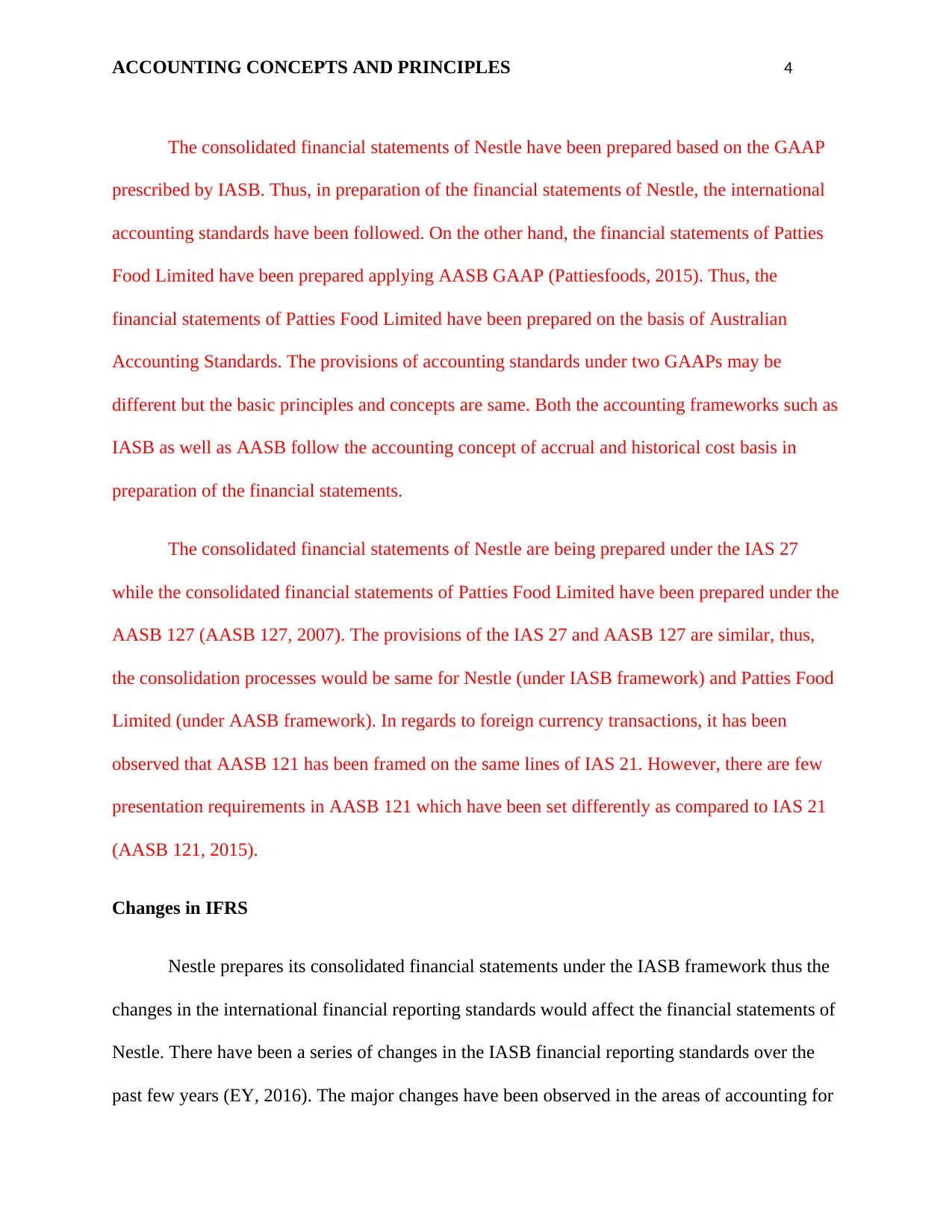
ACCOUNTING CONCEPTS AND PRINCIPLES 4
The consolidated financial statements of Nestle have been prepared based on the GAAP
prescribed by IASB. Thus, in preparation of the financial statements of Nestle, the international
accounting standards have been followed. On the other hand, the financial statements of Patties
Food Limited have been prepared applying AASB GAAP (Pattiesfoods, 2015). Thus, the
financial statements of Patties Food Limited have been prepared on the basis of Australian
Accounting Standards. The provisions of accounting standards under two GAAPs may be
different but the basic principles and concepts are same. Both the accounting frameworks such as
IASB as well as AASB follow the accounting concept of accrual and historical cost basis in
preparation of the financial statements.
The consolidated financial statements of Nestle are being prepared under the IAS 27
while the consolidated financial statements of Patties Food Limited have been prepared under the
AASB 127 (AASB 127, 2007). The provisions of the IAS 27 and AASB 127 are similar, thus,
the consolidation processes would be same for Nestle (under IASB framework) and Patties Food
Limited (under AASB framework). In regards to foreign currency transactions, it has been
observed that AASB 121 has been framed on the same lines of IAS 21. However, there are few
presentation requirements in AASB 121 which have been set differently as compared to IAS 21
(AASB 121, 2015).
Changes in IFRS
Nestle prepares its consolidated financial statements under the IASB framework thus the
changes in the international financial reporting standards would affect the financial statements of
Nestle. There have been a series of changes in the IASB financial reporting standards over the
past few years (EY, 2016). The major changes have been observed in the areas of accounting for
The consolidated financial statements of Nestle have been prepared based on the GAAP
prescribed by IASB. Thus, in preparation of the financial statements of Nestle, the international
accounting standards have been followed. On the other hand, the financial statements of Patties
Food Limited have been prepared applying AASB GAAP (Pattiesfoods, 2015). Thus, the
financial statements of Patties Food Limited have been prepared on the basis of Australian
Accounting Standards. The provisions of accounting standards under two GAAPs may be
different but the basic principles and concepts are same. Both the accounting frameworks such as
IASB as well as AASB follow the accounting concept of accrual and historical cost basis in
preparation of the financial statements.
The consolidated financial statements of Nestle are being prepared under the IAS 27
while the consolidated financial statements of Patties Food Limited have been prepared under the
AASB 127 (AASB 127, 2007). The provisions of the IAS 27 and AASB 127 are similar, thus,
the consolidation processes would be same for Nestle (under IASB framework) and Patties Food
Limited (under AASB framework). In regards to foreign currency transactions, it has been
observed that AASB 121 has been framed on the same lines of IAS 21. However, there are few
presentation requirements in AASB 121 which have been set differently as compared to IAS 21
(AASB 121, 2015).
Changes in IFRS
Nestle prepares its consolidated financial statements under the IASB framework thus the
changes in the international financial reporting standards would affect the financial statements of
Nestle. There have been a series of changes in the IASB financial reporting standards over the
past few years (EY, 2016). The major changes have been observed in the areas of accounting for
Paraphrase This Document
Need a fresh take? Get an instant paraphrase of this document with our AI Paraphraser
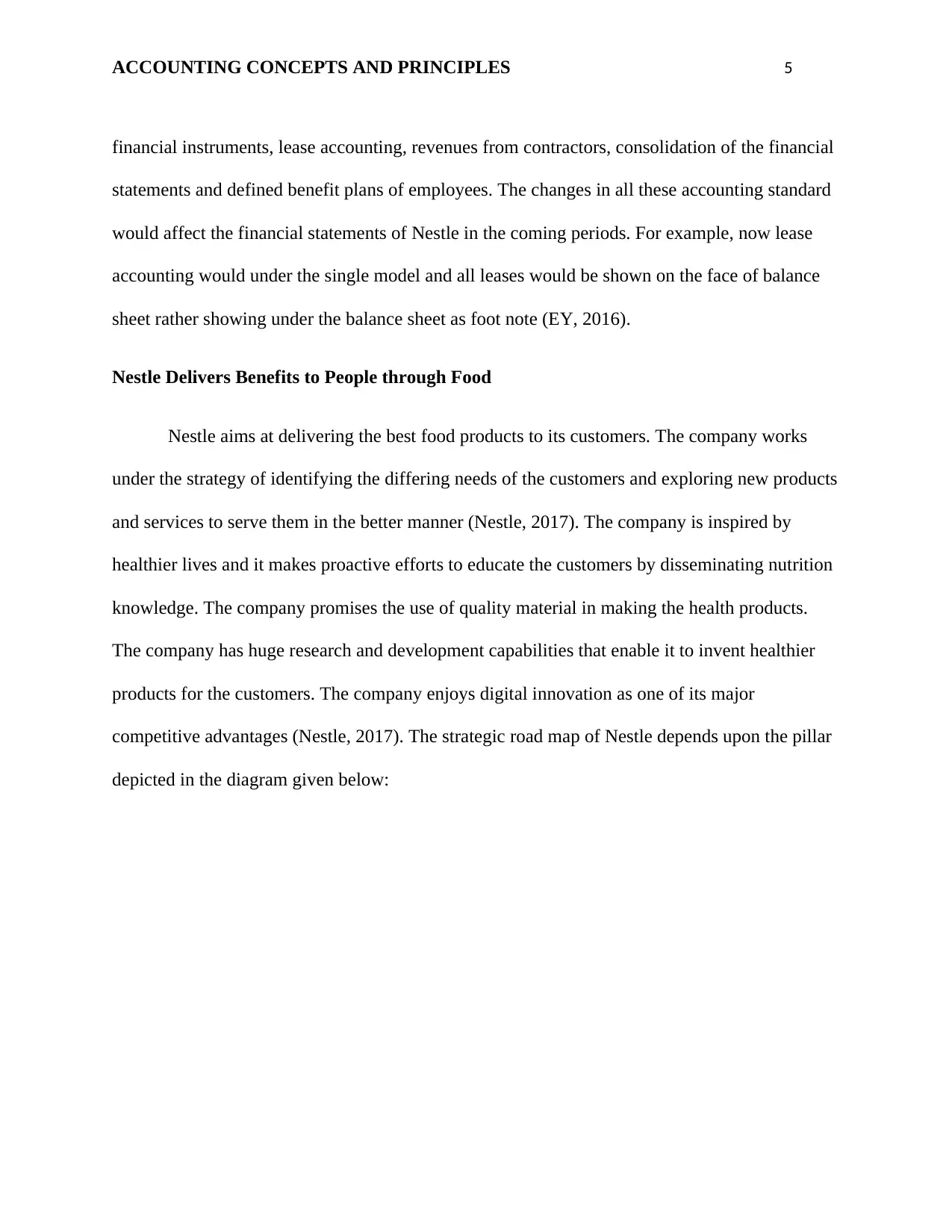
ACCOUNTING CONCEPTS AND PRINCIPLES 5
financial instruments, lease accounting, revenues from contractors, consolidation of the financial
statements and defined benefit plans of employees. The changes in all these accounting standard
would affect the financial statements of Nestle in the coming periods. For example, now lease
accounting would under the single model and all leases would be shown on the face of balance
sheet rather showing under the balance sheet as foot note (EY, 2016).
Nestle Delivers Benefits to People through Food
Nestle aims at delivering the best food products to its customers. The company works
under the strategy of identifying the differing needs of the customers and exploring new products
and services to serve them in the better manner (Nestle, 2017). The company is inspired by
healthier lives and it makes proactive efforts to educate the customers by disseminating nutrition
knowledge. The company promises the use of quality material in making the health products.
The company has huge research and development capabilities that enable it to invent healthier
products for the customers. The company enjoys digital innovation as one of its major
competitive advantages (Nestle, 2017). The strategic road map of Nestle depends upon the pillar
depicted in the diagram given below:
financial instruments, lease accounting, revenues from contractors, consolidation of the financial
statements and defined benefit plans of employees. The changes in all these accounting standard
would affect the financial statements of Nestle in the coming periods. For example, now lease
accounting would under the single model and all leases would be shown on the face of balance
sheet rather showing under the balance sheet as foot note (EY, 2016).
Nestle Delivers Benefits to People through Food
Nestle aims at delivering the best food products to its customers. The company works
under the strategy of identifying the differing needs of the customers and exploring new products
and services to serve them in the better manner (Nestle, 2017). The company is inspired by
healthier lives and it makes proactive efforts to educate the customers by disseminating nutrition
knowledge. The company promises the use of quality material in making the health products.
The company has huge research and development capabilities that enable it to invent healthier
products for the customers. The company enjoys digital innovation as one of its major
competitive advantages (Nestle, 2017). The strategic road map of Nestle depends upon the pillar
depicted in the diagram given below:
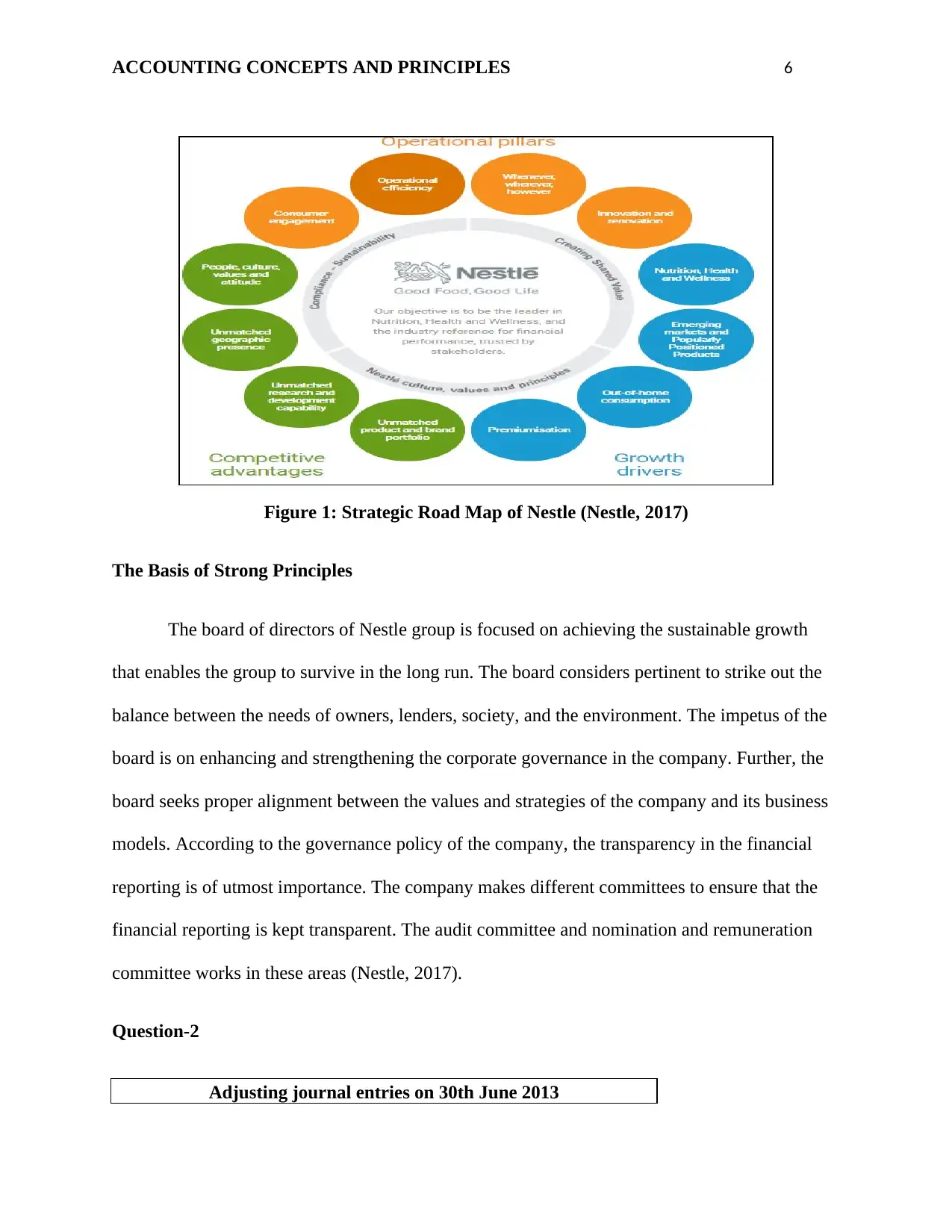
ACCOUNTING CONCEPTS AND PRINCIPLES 6
Figure 1: Strategic Road Map of Nestle (Nestle, 2017)
The Basis of Strong Principles
The board of directors of Nestle group is focused on achieving the sustainable growth
that enables the group to survive in the long run. The board considers pertinent to strike out the
balance between the needs of owners, lenders, society, and the environment. The impetus of the
board is on enhancing and strengthening the corporate governance in the company. Further, the
board seeks proper alignment between the values and strategies of the company and its business
models. According to the governance policy of the company, the transparency in the financial
reporting is of utmost importance. The company makes different committees to ensure that the
financial reporting is kept transparent. The audit committee and nomination and remuneration
committee works in these areas (Nestle, 2017).
Question-2
Adjusting journal entries on 30th June 2013
Figure 1: Strategic Road Map of Nestle (Nestle, 2017)
The Basis of Strong Principles
The board of directors of Nestle group is focused on achieving the sustainable growth
that enables the group to survive in the long run. The board considers pertinent to strike out the
balance between the needs of owners, lenders, society, and the environment. The impetus of the
board is on enhancing and strengthening the corporate governance in the company. Further, the
board seeks proper alignment between the values and strategies of the company and its business
models. According to the governance policy of the company, the transparency in the financial
reporting is of utmost importance. The company makes different committees to ensure that the
financial reporting is kept transparent. The audit committee and nomination and remuneration
committee works in these areas (Nestle, 2017).
Question-2
Adjusting journal entries on 30th June 2013
⊘ This is a preview!⊘
Do you want full access?
Subscribe today to unlock all pages.

Trusted by 1+ million students worldwide
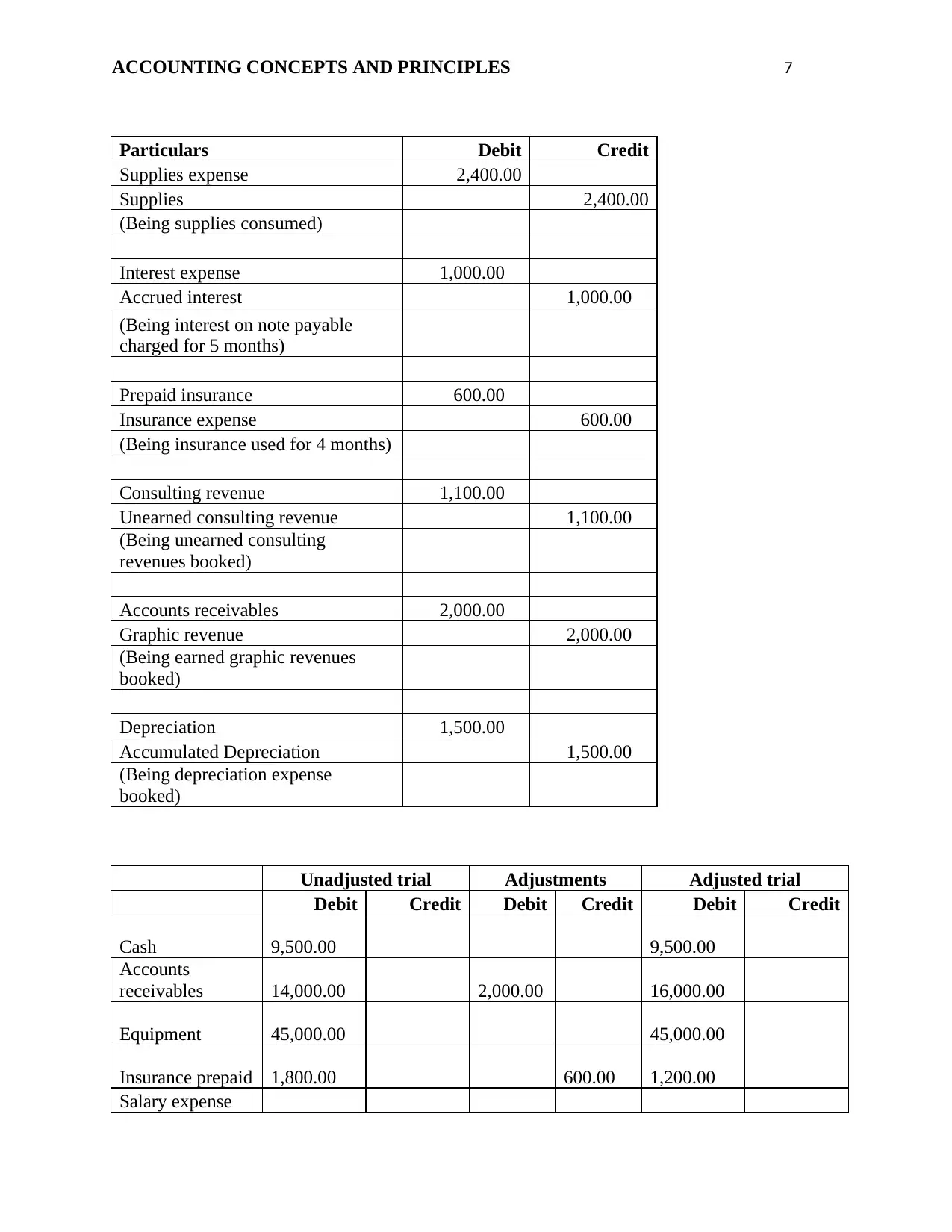
ACCOUNTING CONCEPTS AND PRINCIPLES 7
Particulars Debit Credit
Supplies expense 2,400.00
Supplies 2,400.00
(Being supplies consumed)
Interest expense 1,000.00
Accrued interest 1,000.00
(Being interest on note payable
charged for 5 months)
Prepaid insurance 600.00
Insurance expense 600.00
(Being insurance used for 4 months)
Consulting revenue 1,100.00
Unearned consulting revenue 1,100.00
(Being unearned consulting
revenues booked)
Accounts receivables 2,000.00
Graphic revenue 2,000.00
(Being earned graphic revenues
booked)
Depreciation 1,500.00
Accumulated Depreciation 1,500.00
(Being depreciation expense
booked)
Unadjusted trial Adjustments Adjusted trial
Debit Credit Debit Credit Debit Credit
Cash 9,500.00 9,500.00
Accounts
receivables 14,000.00 2,000.00 16,000.00
Equipment 45,000.00 45,000.00
Insurance prepaid 1,800.00 600.00 1,200.00
Salary expense
Particulars Debit Credit
Supplies expense 2,400.00
Supplies 2,400.00
(Being supplies consumed)
Interest expense 1,000.00
Accrued interest 1,000.00
(Being interest on note payable
charged for 5 months)
Prepaid insurance 600.00
Insurance expense 600.00
(Being insurance used for 4 months)
Consulting revenue 1,100.00
Unearned consulting revenue 1,100.00
(Being unearned consulting
revenues booked)
Accounts receivables 2,000.00
Graphic revenue 2,000.00
(Being earned graphic revenues
booked)
Depreciation 1,500.00
Accumulated Depreciation 1,500.00
(Being depreciation expense
booked)
Unadjusted trial Adjustments Adjusted trial
Debit Credit Debit Credit Debit Credit
Cash 9,500.00 9,500.00
Accounts
receivables 14,000.00 2,000.00 16,000.00
Equipment 45,000.00 45,000.00
Insurance prepaid 1,800.00 600.00 1,200.00
Salary expense
Paraphrase This Document
Need a fresh take? Get an instant paraphrase of this document with our AI Paraphraser
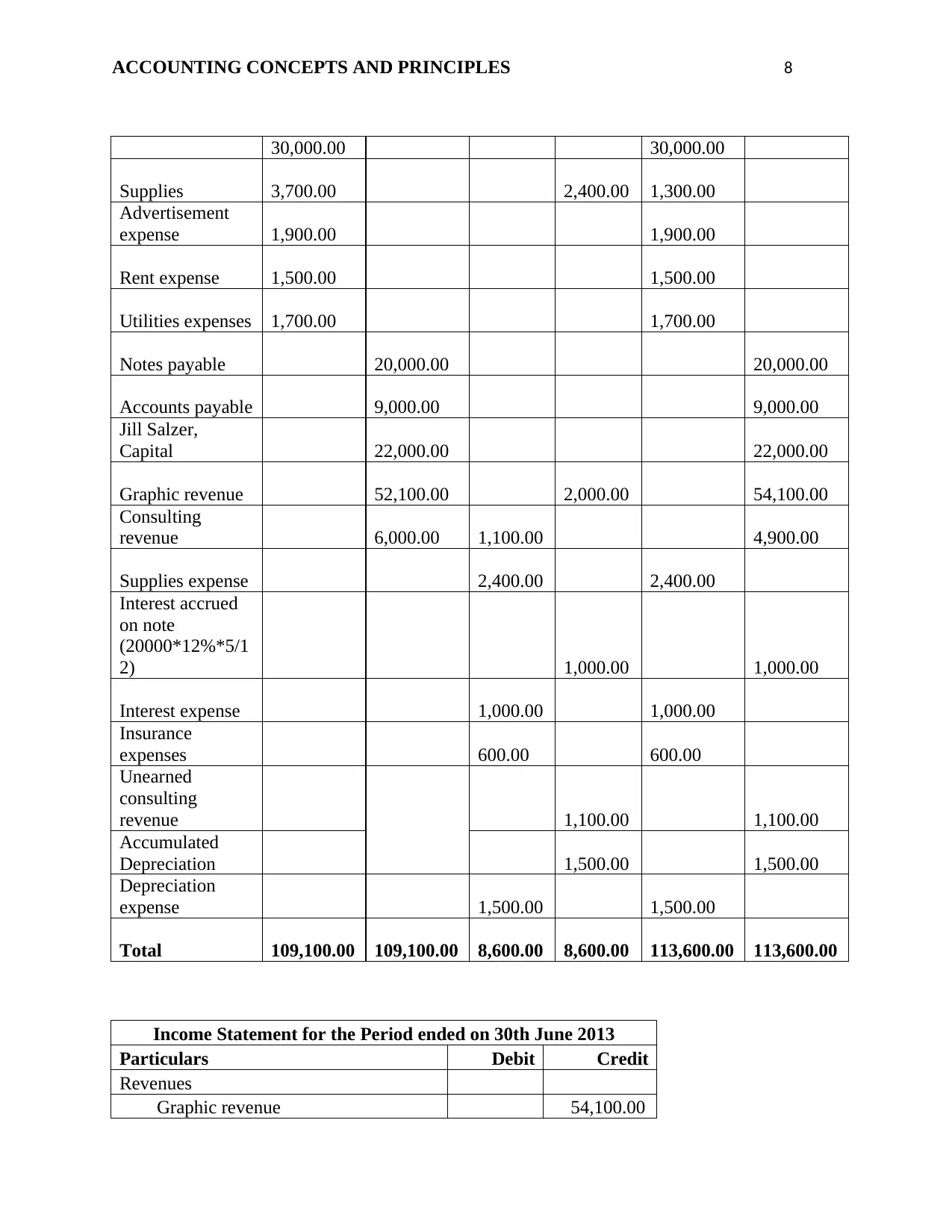
ACCOUNTING CONCEPTS AND PRINCIPLES 8
30,000.00 30,000.00
Supplies 3,700.00 2,400.00 1,300.00
Advertisement
expense 1,900.00 1,900.00
Rent expense 1,500.00 1,500.00
Utilities expenses 1,700.00 1,700.00
Notes payable 20,000.00 20,000.00
Accounts payable 9,000.00 9,000.00
Jill Salzer,
Capital 22,000.00 22,000.00
Graphic revenue 52,100.00 2,000.00 54,100.00
Consulting
revenue 6,000.00 1,100.00 4,900.00
Supplies expense 2,400.00 2,400.00
Interest accrued
on note
(20000*12%*5/1
2) 1,000.00 1,000.00
Interest expense 1,000.00 1,000.00
Insurance
expenses 600.00 600.00
Unearned
consulting
revenue 1,100.00 1,100.00
Accumulated
Depreciation 1,500.00 1,500.00
Depreciation
expense 1,500.00 1,500.00
Total 109,100.00 109,100.00 8,600.00 8,600.00 113,600.00 113,600.00
Income Statement for the Period ended on 30th June 2013
Particulars Debit Credit
Revenues
Graphic revenue 54,100.00
30,000.00 30,000.00
Supplies 3,700.00 2,400.00 1,300.00
Advertisement
expense 1,900.00 1,900.00
Rent expense 1,500.00 1,500.00
Utilities expenses 1,700.00 1,700.00
Notes payable 20,000.00 20,000.00
Accounts payable 9,000.00 9,000.00
Jill Salzer,
Capital 22,000.00 22,000.00
Graphic revenue 52,100.00 2,000.00 54,100.00
Consulting
revenue 6,000.00 1,100.00 4,900.00
Supplies expense 2,400.00 2,400.00
Interest accrued
on note
(20000*12%*5/1
2) 1,000.00 1,000.00
Interest expense 1,000.00 1,000.00
Insurance
expenses 600.00 600.00
Unearned
consulting
revenue 1,100.00 1,100.00
Accumulated
Depreciation 1,500.00 1,500.00
Depreciation
expense 1,500.00 1,500.00
Total 109,100.00 109,100.00 8,600.00 8,600.00 113,600.00 113,600.00
Income Statement for the Period ended on 30th June 2013
Particulars Debit Credit
Revenues
Graphic revenue 54,100.00
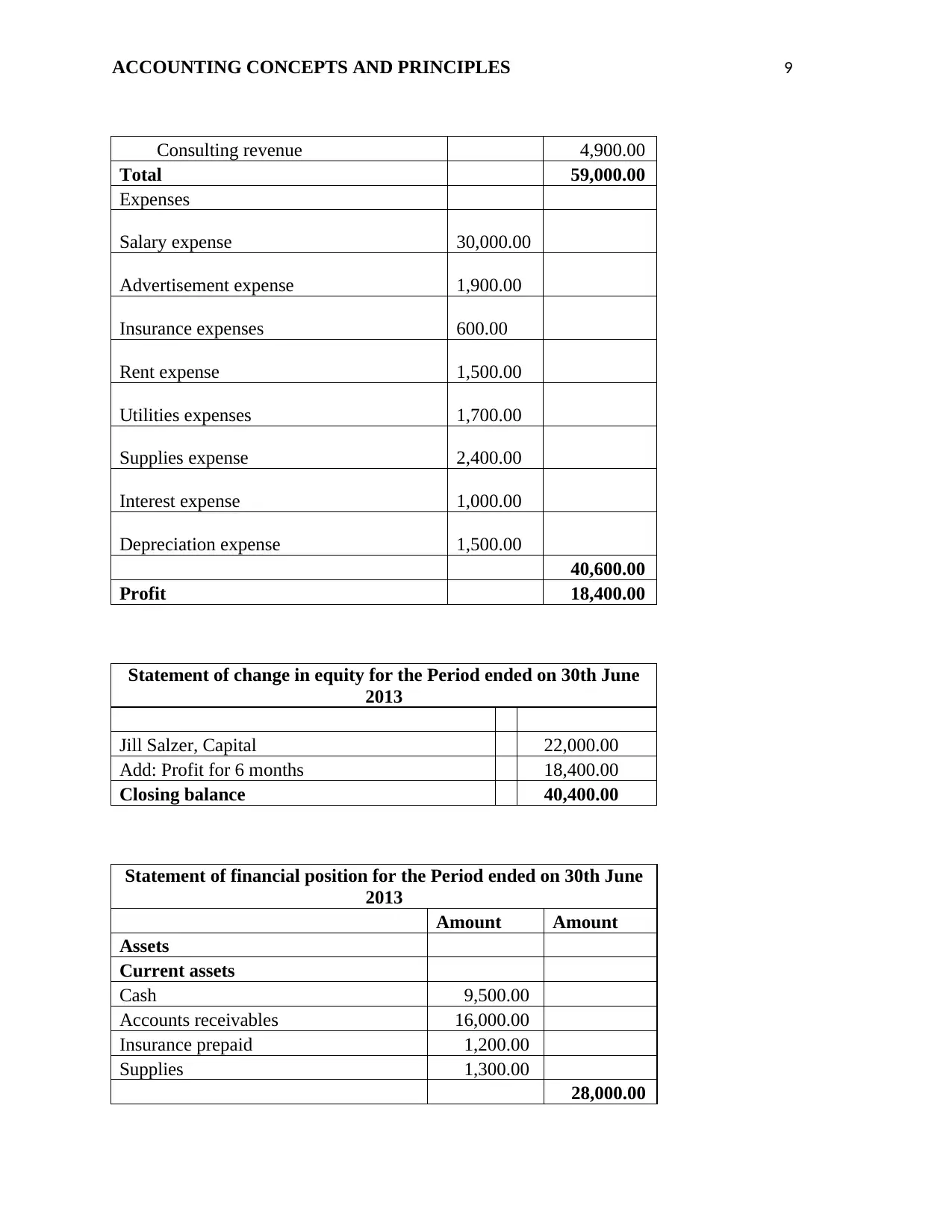
ACCOUNTING CONCEPTS AND PRINCIPLES 9
Consulting revenue 4,900.00
Total 59,000.00
Expenses
Salary expense 30,000.00
Advertisement expense 1,900.00
Insurance expenses 600.00
Rent expense 1,500.00
Utilities expenses 1,700.00
Supplies expense 2,400.00
Interest expense 1,000.00
Depreciation expense 1,500.00
40,600.00
Profit 18,400.00
Statement of change in equity for the Period ended on 30th June
2013
Jill Salzer, Capital 22,000.00
Add: Profit for 6 months 18,400.00
Closing balance 40,400.00
Statement of financial position for the Period ended on 30th June
2013
Amount Amount
Assets
Current assets
Cash 9,500.00
Accounts receivables 16,000.00
Insurance prepaid 1,200.00
Supplies 1,300.00
28,000.00
Consulting revenue 4,900.00
Total 59,000.00
Expenses
Salary expense 30,000.00
Advertisement expense 1,900.00
Insurance expenses 600.00
Rent expense 1,500.00
Utilities expenses 1,700.00
Supplies expense 2,400.00
Interest expense 1,000.00
Depreciation expense 1,500.00
40,600.00
Profit 18,400.00
Statement of change in equity for the Period ended on 30th June
2013
Jill Salzer, Capital 22,000.00
Add: Profit for 6 months 18,400.00
Closing balance 40,400.00
Statement of financial position for the Period ended on 30th June
2013
Amount Amount
Assets
Current assets
Cash 9,500.00
Accounts receivables 16,000.00
Insurance prepaid 1,200.00
Supplies 1,300.00
28,000.00
⊘ This is a preview!⊘
Do you want full access?
Subscribe today to unlock all pages.

Trusted by 1+ million students worldwide
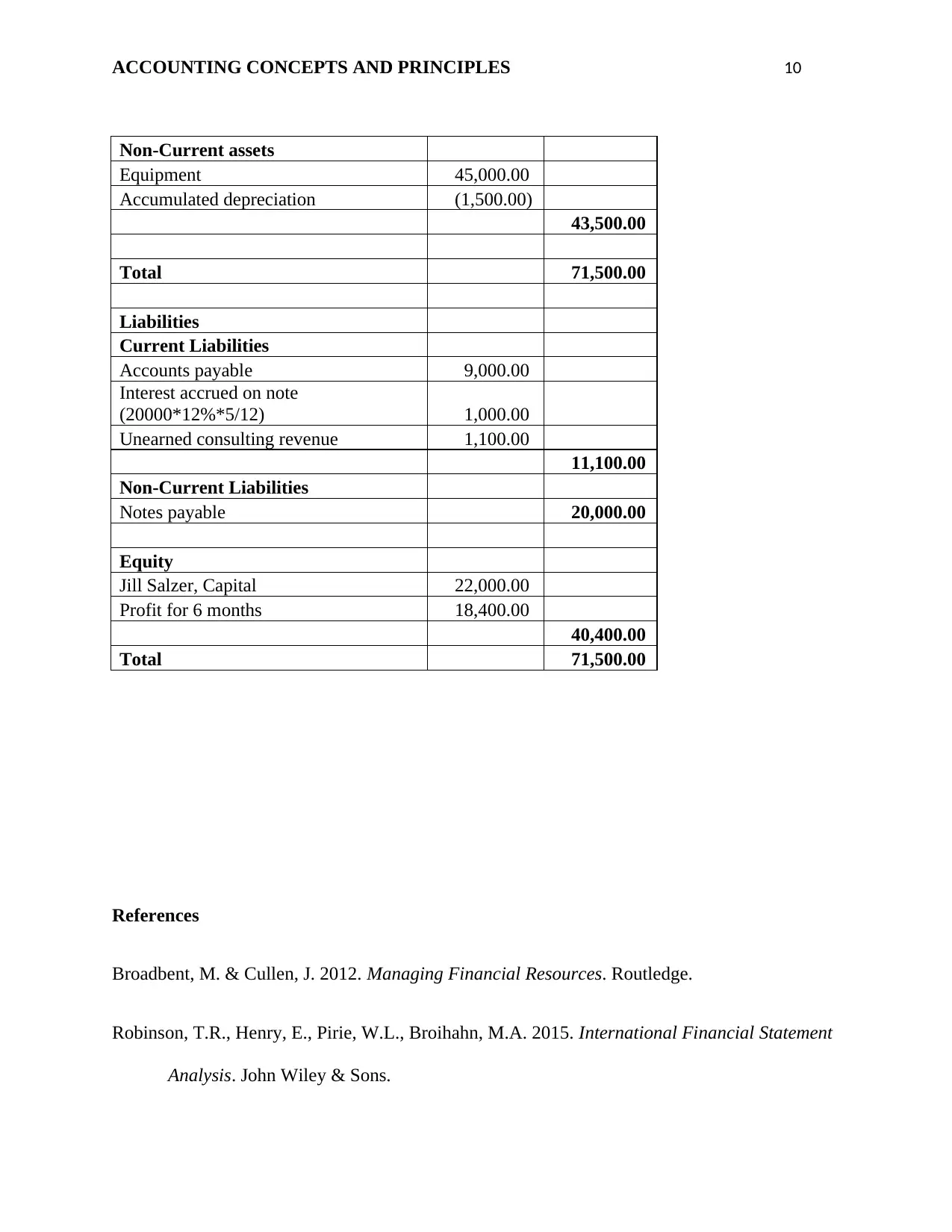
ACCOUNTING CONCEPTS AND PRINCIPLES 10
Non-Current assets
Equipment 45,000.00
Accumulated depreciation (1,500.00)
43,500.00
Total 71,500.00
Liabilities
Current Liabilities
Accounts payable 9,000.00
Interest accrued on note
(20000*12%*5/12) 1,000.00
Unearned consulting revenue 1,100.00
11,100.00
Non-Current Liabilities
Notes payable 20,000.00
Equity
Jill Salzer, Capital 22,000.00
Profit for 6 months 18,400.00
40,400.00
Total 71,500.00
References
Broadbent, M. & Cullen, J. 2012. Managing Financial Resources. Routledge.
Robinson, T.R., Henry, E., Pirie, W.L., Broihahn, M.A. 2015. International Financial Statement
Analysis. John Wiley & Sons.
Non-Current assets
Equipment 45,000.00
Accumulated depreciation (1,500.00)
43,500.00
Total 71,500.00
Liabilities
Current Liabilities
Accounts payable 9,000.00
Interest accrued on note
(20000*12%*5/12) 1,000.00
Unearned consulting revenue 1,100.00
11,100.00
Non-Current Liabilities
Notes payable 20,000.00
Equity
Jill Salzer, Capital 22,000.00
Profit for 6 months 18,400.00
40,400.00
Total 71,500.00
References
Broadbent, M. & Cullen, J. 2012. Managing Financial Resources. Routledge.
Robinson, T.R., Henry, E., Pirie, W.L., Broihahn, M.A. 2015. International Financial Statement
Analysis. John Wiley & Sons.
Paraphrase This Document
Need a fresh take? Get an instant paraphrase of this document with our AI Paraphraser
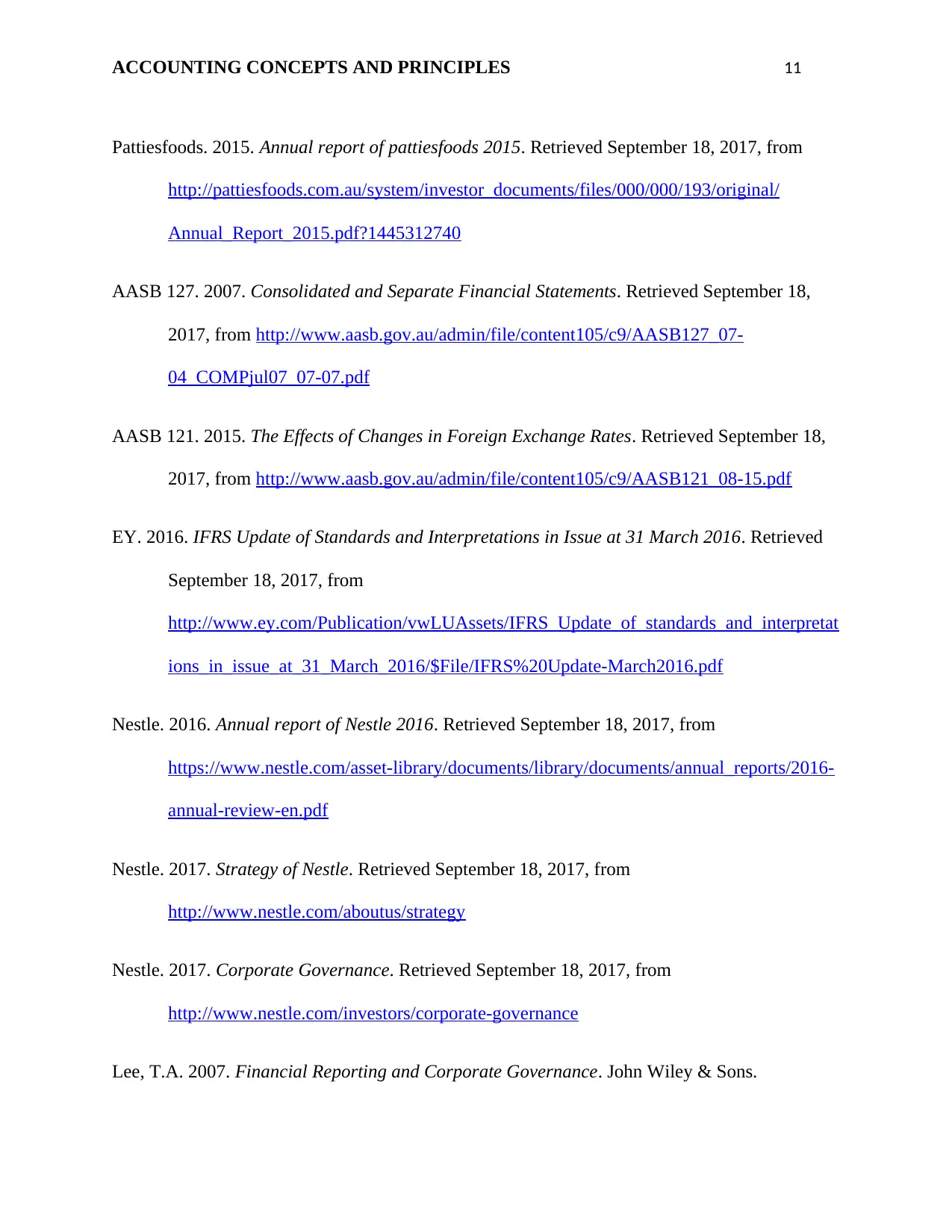
ACCOUNTING CONCEPTS AND PRINCIPLES 11
Pattiesfoods. 2015. Annual report of pattiesfoods 2015. Retrieved September 18, 2017, from
http://pattiesfoods.com.au/system/investor_documents/files/000/000/193/original/
Annual_Report_2015.pdf?1445312740
AASB 127. 2007. Consolidated and Separate Financial Statements. Retrieved September 18,
2017, from http://www.aasb.gov.au/admin/file/content105/c9/AASB127_07-
04_COMPjul07_07-07.pdf
AASB 121. 2015. The Effects of Changes in Foreign Exchange Rates. Retrieved September 18,
2017, from http://www.aasb.gov.au/admin/file/content105/c9/AASB121_08-15.pdf
EY. 2016. IFRS Update of Standards and Interpretations in Issue at 31 March 2016. Retrieved
September 18, 2017, from
http://www.ey.com/Publication/vwLUAssets/IFRS_Update_of_standards_and_interpretat
ions_in_issue_at_31_March_2016/$File/IFRS%20Update-March2016.pdf
Nestle. 2016. Annual report of Nestle 2016. Retrieved September 18, 2017, from
https://www.nestle.com/asset-library/documents/library/documents/annual_reports/2016-
annual-review-en.pdf
Nestle. 2017. Strategy of Nestle. Retrieved September 18, 2017, from
http://www.nestle.com/aboutus/strategy
Nestle. 2017. Corporate Governance. Retrieved September 18, 2017, from
http://www.nestle.com/investors/corporate-governance
Lee, T.A. 2007. Financial Reporting and Corporate Governance. John Wiley & Sons.
Pattiesfoods. 2015. Annual report of pattiesfoods 2015. Retrieved September 18, 2017, from
http://pattiesfoods.com.au/system/investor_documents/files/000/000/193/original/
Annual_Report_2015.pdf?1445312740
AASB 127. 2007. Consolidated and Separate Financial Statements. Retrieved September 18,
2017, from http://www.aasb.gov.au/admin/file/content105/c9/AASB127_07-
04_COMPjul07_07-07.pdf
AASB 121. 2015. The Effects of Changes in Foreign Exchange Rates. Retrieved September 18,
2017, from http://www.aasb.gov.au/admin/file/content105/c9/AASB121_08-15.pdf
EY. 2016. IFRS Update of Standards and Interpretations in Issue at 31 March 2016. Retrieved
September 18, 2017, from
http://www.ey.com/Publication/vwLUAssets/IFRS_Update_of_standards_and_interpretat
ions_in_issue_at_31_March_2016/$File/IFRS%20Update-March2016.pdf
Nestle. 2016. Annual report of Nestle 2016. Retrieved September 18, 2017, from
https://www.nestle.com/asset-library/documents/library/documents/annual_reports/2016-
annual-review-en.pdf
Nestle. 2017. Strategy of Nestle. Retrieved September 18, 2017, from
http://www.nestle.com/aboutus/strategy
Nestle. 2017. Corporate Governance. Retrieved September 18, 2017, from
http://www.nestle.com/investors/corporate-governance
Lee, T.A. 2007. Financial Reporting and Corporate Governance. John Wiley & Sons.
1 out of 11
Related Documents
Your All-in-One AI-Powered Toolkit for Academic Success.
+13062052269
info@desklib.com
Available 24*7 on WhatsApp / Email
![[object Object]](/_next/static/media/star-bottom.7253800d.svg)
Unlock your academic potential
Copyright © 2020–2025 A2Z Services. All Rights Reserved. Developed and managed by ZUCOL.





